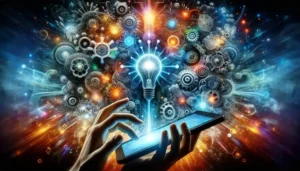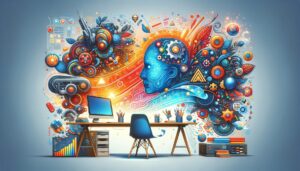At times, creativity appears to be uncontrollable, swift, and elusive. Artists, writers, designers, and anyone working in the art world will always face challenges. They manifest as mental blocks, a constant stream of ideas, an inability to collaborate, or simply an overwhelming pressure to always come up with something new. But with the rapid advances in technology in the digital age, the way creativity functions is changing. It’s no longer a lone mind working alone with only its tools and ideas; today’s technology makes creativity more accessible than ever before for anyone with a creative block. This article discusses how advanced technology can break down these barriers, spark creativity, and make it easier than ever to turn ideas into reality.
With artificial intelligence helping generate ideas and enabling immersive experiences through augmented and virtual reality, creative professionals today have more tools at their disposal than ever before. Today’s digital platforms make it easy for creatives from all over the world to collaborate. Furthermore, analytics can transform raw data into compelling stories, designs, or visuals. Cloud computing, on the other hand, ensures that ideas and work are not confined to a single device or location. This article shows how the new wave of technology is changing creativity in the digital age. If you find yourself staring at a blank sheet of paper or canvas, frustrated by limitations, or isolated from potential collaborators, read this book.
AI-Powered Creativity Tools
Artificial intelligence has rapidly emerged as a reliable ally for artists and designers seeking to overcome creative obstacles and enhance their workflow. AI doesn’t take away human creativity; instead, it works with humans to generate new ideas, automates tedious tasks, and even writes novels based on prompts. AI platforms can now automatically suggest story ideas, enhance language, and generate dialogue, breathing new life into shelved writing projects. AI can look at parts of a design and suggest layouts, color schemes, and patterns to graphic artists, quickly generating new ideas.
People who create music also benefit greatly. AI tools can write melodies, harmonies, and even complete backing tracks that singers can use as a starting point. AI takes over the basic tasks of composing, allowing musicians to focus on editing, refining, and adding their style. Even in advertising and content creation, AI copywriting assistants can help marketers come up with catchy slogans, intriguing headlines, and text that is engaging to read. This capability removes the common obstacle of a blank page. Generally speaking, AI is not about automation for its sake. Rather, it is about turning creative obstacles into springboards by providing people with an endless source of ideas and useful information.
Digital Collaboration Platform
The ability to collaborate instantly with people anywhere in the world is one of the most important ways technology is transforming creativity. Digital tools like shared canvases, writing instruments, and project management suites make it easier for people to come up with ideas together, regardless of where they are or what time it is. A designer in New York, a video editor in London, and an illustrator in Tokyo can all work on the same project, sharing comments, changes, and assets almost instantly. Platforms like Figma and Miro have changed the way people think about design, allowing teams to speed up changes rather than sending static files via email.
Text-based tools like Google Docs and collaborative writing apps have also changed the way writers, journalists, and academics work. This open communication often leads to a wealth of new ideas as team members exchange divergent thoughts, solve problems together, and view projects from different perspectives. Technology collaboration ensures the preservation of the best ideas and allows individuals to maintain their creativity without waiting for the next meeting. When communication is seamless, version control is built in, and processes run smoothly, even the largest projects become more manageable.
AR and VR Create an Immersive Experience
Augmented reality (AR) and virtual reality (VR) give creatives new ways to express themselves. These technologies break down the barriers between the digital and physical worlds, opening up a wealth of exciting new possibilities for artists, writers, and marketers. AR adds digital information to people’s real-world surroundings, allowing creators to showcase their work in real life rather than just on a static page or screen. Whether it’s viewing a sculpture in a park or furniture in a potential buyer’s home, AR makes creative work interactive and fun.
Virtual reality, on the other hand, places people in carefully designed digital worlds where they can view, walk around, and even participate in stories, artwork, and learning activities. And that’s not all VR can do. It’s also useful in industries like design, where clients can view digital models of buildings before the bricks are laid. It’s also changed the way theater, school, and even therapy are delivered. These immersive experiences can free creativity from the constraints of two-dimensional thinking, creating a new wave of projects that push boundaries and spark new ideas.
Be Creative with Data Analytics
Today’s creators don’t just rely on intuition and instinct; they have access to data-driven insights that help them determine what to build, what their audience wants, and how effective their creative strategies are. With data analytics tools, you can gain insight into people’s behavior, spot emerging trends, and see which parts of a campaign, image, or song are most effective. By looking at metrics like page views, engagement time, and social shares, writers and content creators can ensure their work is having the most impact, without guesswork and with precision.
Analytics can reveal patterns in things like customer reviews or sales figures for businesses and brands. These patterns will inform the content and style of future events. Designers use analytics software to track which visual cues grab people’s attention and prompt them to take action. Musicians can use streaming data to create records that match the habits of real listeners. When creativity and analytics meet, projects become both creative and well-suited for real-world success. This combination makes creative blocks less scary and easier to overcome.
Cloud Computing, Easy to Use
Invisible cloud computing powers many of the creative technologies we use every day. Cloud technology ensures that creative work doesn’t stop due to hardware failures or mobility, because resources, software, and data are accessible from anywhere. Writers can start an article at home and review it on the way to work. Photographers can quickly upload, catalog, and share original photos with others. Backups and version control are automatic, so you don’t have to worry about losing files or accidentally overwriting important work.
Cloud storage and cloud-based applications make it easier for creative teams working in different locations to work on assets and collaborate in real time. Everyone starts with the most recent file, so comments and inspiration can be acted on quickly as they arise. It’s useful for freelancers, small businesses, and large studios because they can tap into a powerful creative suite without having to pay for expensive infrastructure or full-time IT support. Ultimately, cloud computing breaks down barriers, solves logistical problems, and makes it possible for anyone with an idea to participate in any project, big or small.
Finding New Ways to be Creative in a Connected World
Creativity is constantly changing thanks to new technologies. The present moment is an especially exciting time to be a creator. In the past, obstacles meant anger and inactivity. Today, digital tools offer various ways to generate ideas, complete tasks, and connect with others. Artificial intelligence, collaborative platforms, immersive worlds, data analytics, and cloud computing are no longer frills; they are indispensable tools for artists. Each goal is designed to break down old barriers and give individuals and groups the tools they need to achieve their big dreams.
When technology meets human creativity, the possibilities are as endless as our desire to create new things. Whether you’ve been involved in art for a while or are just getting started, using these techniques can help you solve problems, strengthen your skills, and share your work with more people. Stay open-minded, explore new tools, and use them to change not only how you create, but also what you think is possible.
FAQs:
1. How are creative AI tools different from other types of software?
Artificial intelligence tools for creative purposes go beyond preset capabilities because they learn and change over time to adapt to each user’s style. They provide suggestions and propose ideas that can change with each project. They automate tedious, repetitive tasks and add a personal touch that regular, impersonal software can’t.
2. Where can creatives collaborate in digital spaces?
Platforms like Figma, Miro, Adobe Creative Cloud, and Google Workspace enable creative teams to collaborate in various ways. These platforms provide shared workspaces, built-in communication, and unified resources that teams can access and introduce changes to anywhere, at any time.
3. What impact will AR and VR have on design and storytelling?
AR and VR immerse you in the story, enhancing the engagement of both the story and the design. They immerse people in digital stories or 3D worlds, creating interest and giving creators new ways to play with space, movement, and engagement.
4. What role does data analytics play in artistic creation?
Data analytics can tell you a lot about what your audience likes and what trends are emerging. This information can help you make creative decisions and improve your strategy. This feedback loop can help you adjust projects to better connect with and inspire your audience.
5. Is it safe to store artwork in the cloud?
Yes, reliable cloud services use advanced encryption and security measures to keep creative files safe. Most cloud platforms offer a safe and secure way to store important files, with features like multi-factor login and automatic backup.




